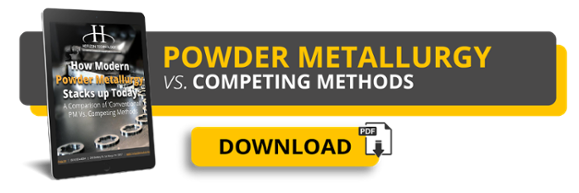Metal injection molding (MIM) is a fairly new fabrication method, as least compared with centuries-old concepts like powder metallurgy. MIM evolved from a need for more complex metal parts with high degrees of accuracy and consistency.
Metal injection molding applications cover a wide range of industries, from aerospace to medical. So, what about your industry and your specific project? We’ll take a closer look at MIM in terms of:
- Material possibilities
- End uses
- Costs
We'll also take a look at metal injection molding vs powder metallurgy, two fabrication methods similar in nature but racing to meet the needs of the next great application.
Metal Injection Molding Applications
What Is Metal Injection Molding?
MIM was born out of the die casting world, when design engineers started to need more complex shapes that retained high strength
MIM’s roots date back to the 1970s, and many thought it was going to be the next big thing throughout the 1980s … and 1990s … and 2000s. Despite great potential and claims it would change metal making as we know it, its applications remain limited.
There are many metal injection molding parts made for the auto industry. But MIM is still a right-time-right-place application, rather than a consistent go-to for small metal parts manufacturing.
Anywho, what is metal injection molding, and how does it work? The name gives some of it away.
MIM blends metal powders with polymer binders to create a solution. This solution is then injected into a molding machine, where heat is applied. The solution is then sintered at a very high temperature to increase the powder’s density.
Metal injection molding materials range from stainless steel to low-alloy steel.
Early on, a flip phone case was about the biggest shape you could make With MIM. The process is capable of creating somewhat larger parts today.
Metal Injection Molding Advantages and Disadvantages
The Good
MIM does what its pioneers sought out to do: Create high-density parts with complex geometries.
Unlike some competing fabrication processes, MIM creates components with
- Consistency
- Accuracy
- Reliability
It’s especially useful for creating small, fine metal parts where there’s little or no room for error. Another benefit of MIM is that it eliminates machining, something that many metal injection molding companies are quick to promote to their customers.
The Ugly
There are pros and cons to every process, and MIM is not immune. Metal injection molding’s cost is an automatic disqualifier for many projects.
In virtually all cases, MIM can’t compete with powder metallurgy in a price battle. Estimates say the feedstock for MIM can cost up to $12 per pound, compared to the $1 to $2 per pound for conventional powder metallurgy.
Part of the reason for the high cost is that MIM requires elevated temperatures for sintering. Another is that much as 25% of the material is removed during processing; shrinking also has to be taken into account. A MIM part may experience anywhere from 15-20% linear shrinkage during processing.
These two factors can really dip into production budgets.
Metal Injection Molding vs. Powder Metallurgy
Powder metallurgy (PM) can’t create the same level of complex geometries MIM excels at. But it’s still a viable, and often preferred, manufacturing option over MIM.
Traditional PM uses a dry powder mix. It uses high pressure to compact columns of powder into a shape, whereas MIM uses a “wet” slurry with relatively low pressures and thus the ability to form more complex geometries.
Both processes use a closed die. The difference is that PM more or less needs straight walls, whereas MIM can do things impossible in PM like:
- Undercuts
- Severe draft angles
- Complex through-holes
- Surface features
Powder metallurgy also works differently from MIM in that it blends powders and lubricants together, then places the solution into the die to create your desired shape. The solution is pressed and compacted, then sintered in a furnace to bond the metal powder together.
Your choice may come down to the expertise and experience of the conventional powder metallurgy manufacturer. For example, those who run state-of-the-art shops using “traditional” PM (an oxymoron if there ever was one) can still achieve great part density and high shape complexity compared with other manufacturing methods. The two technologies aren’t far apart when it comes to end product quality -- only in price.
Powder metallurgy is ideal for the mass production of high-quality parts at a reasonable price. It’s also plenty capable of enhancing part properties by using advanced powder materials.
Need Help With Your Decision?
For more information on the key differences between PM and MIM, check out this blog post here.
You can also ask a powder metallurgy company directly whether your design is manufacturable with PM or needs MIM’s capabilities instead. You can contact us below to see if we can improve your part (and cost-efficiency!):



